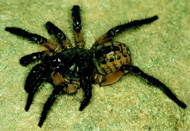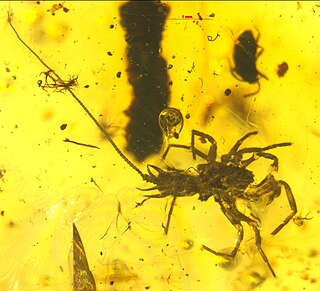
The family Dipluridae, known as curtain-web spiders are a group of spiders in the infraorder Mygalomorphae, that have two pairs of booklungs, and chelicerae (fangs) that move up and down in a stabbing motion. A number of genera, including that of the Sydney funnel-web spider (Atrax), used to be classified in this family but have now been moved to Atracidae.

The Mesothelae are a suborder of spiders. As of April 2024, two extant families were accepted by the World Spider Catalog, Liphistiidae and Heptathelidae. Alternatively, the Heptathelidae can be treated as a subfamily of a more broadly circumscribed Liphistiidae. There are also a number of extinct families.

Heptathela is a genus of spiders that includes the Kimura spider. They are trapdoor spiders of the family Heptathelidae and are found in Japan, including Okinawa and the Ryukyu Islands. Spiders of this genus lack venom glands.

Araneida is a subgroup of Tetrapulmonata. It was originally defined by Jörg Wunderlich in 2015 as a subgroup of Araneae, including all true spiders, with Wunderlich also including Uraraneida within Araneae. Araneida was redefined by Wunderlich in 2019 to include all modern spiders (Araneae), as well as Chimerarachnida, but excluding Uraraneida. Chimerarachnida and Araneae both possess spinnerets, which are absent in Uraraneida. Uraraneida and Araneida are grouped together in the clade Serikodiastida.

Opisthothelae is a suborder of spiders within the order Araneae, containing Mygalomorphae and Araneomorphae, but excluding Mesothelae. The Opisthothelae are sometimes presented as an unranked clade and sometimes as a suborder of Araneae. In the latter case, Mygalomorphae and Araneomorphae are treated as infraorders.

Liphistius is a genus of basal trapdoor spiders in the family Liphistiidae. They are found in Japan, China, and Southeast Asia.

Mongolarachne is an extinct genus of spiders placed in the monogeneric family Mongolarachnidae. The genus contains only one species, Mongolarachne jurassica, described in 2013, which is presently the largest fossilized spider on record. The type species was originally described as Nephila jurassica and placed in the living genus Nephila which contains the golden silk orb-weavers.

Ryuthela is a spider genus in the family Heptathelidae. This genus, as well as their closest relatives, Heptathela, formed when land masses from present-day Japan separated from the rest of Asia, forming islands in the late Miocene. Speciation of Ryuthela and Heptathela also occurred during this time, because of the further separation of islands, causing allopatric speciation.
Burmesarchaea is a diverse extinct genus of spiders, placed in the family Archaeidae. The type species Burmesarchaea grimaldii was first described in 2003 and least 13 more species have been assigned to the genus. The genus has been exclusively found in Cretaceous Burmese amber, which is dated to 99 million years ago.

Qiongthela is a genus of spiders in the family Heptathelidae. As of 2021, it contains 14 species.
Microsynotaxus is a genus of Australian araneomorph spiders in the family Physoglenidae that was first described by J. Wunderlich in 2008. As of September 2019 it contains two species, both found in Queensland: M. calliope and M. insolens.

Leviellus, synonym Stroemiellus, is a genus of orb-weaver spiders first described by J. Wunderlich in 2004.
Macarophaeus is a genus of European ground spiders that was first described by J. Wunderlich in 2011. As of May 2019 it contains only three species: M. cultior, M. insignis, and M. varius.
Achaeridion is a monotypic genus of comb-footed spiders containing the single species, Achaeridion conigerum. It was first described by J. Wunderlich in 2008, and is found in Europe.
Tamanidion is a monotypic genus of Asian comb-footed spiders containing the single species, Tamanidion multidenticuli. It was first described by J. Wunderlich in 2011, and is found in Malaysia.

Chimerarachne is a genus of extinct arachnids, containing five species. Fossils of Chimerarachne were discovered in Burmese amber from Myanmar which dates to the mid-Cretaceous, about 100 million years ago. It is thought to be closely related to spiders, but outside any living spider clade. The earliest spider fossils are from the Carboniferous, requiring at least a 170 myr ghost lineage with no fossil record. The size of the animal is quite small, being only 2.5 millimetres (0.098 in) in body length, with the tail being about 3 millimetres (0.12 in) in length. These fossils resemble spiders in having two of their key defining features: spinnerets for spinning silk, and a modified male organ on the pedipalp for transferring sperm. At the same time they retain a whip-like tail, rather like that of a whip scorpion and uraraneids. Chimerarachne is not ancestral to spiders, being much younger than the oldest spiders which are known from the Carboniferous, but it appears to be a late survivor of an extinct group which was probably very close to the origins of spiders. It suggests that there used to be spider-like animals with tails which lived alongside true spiders for at least 200 million years.
Priscaleclercera is a genus of araneomorph spiders in the family Psilodercidae, containing seven species. The genus was first described by Jorge Wunderlich in 2017, and its fossils have been found in Burmese amber, while live specimens have been found in Indonesia (Sulawesi).

Lagonomegopidae is an extinct family of spiders known from the Cretaceous period. Members of the family are distinguished by a large pair of eyes, positioned on the anterolateral flanks of the carapace, with the rest of the eyes being small. They have generally been considered members of Palpimanoidea, but this has recently been questioned. Members of the family are known from the late Early Cretaceous (Albian) to near the end of the Late Cretaceous (Campanian) of Eurasia, North America and the Middle East, which was then attached to Africa as part of Gondwana. They are generally assumed to have been free living hunters as opposed to web builders.
Jörg Wunderlich is a German arachnologist and palaeontologist. He is best known for his study of spiders in amber, describing over 1000 species, 300 genera, 50 tribes/subfamilies and 18 families in over 180 publications. Unlike most other arachnologists Jörg has never held any academic position and has worked as a private individual with no financial support for travel or equipment.

Heptathelidae is a family of spiders. It has been sunk within the family Liphistiidae, but as of April 2024 was accepted by the World Spider Catalog. It is placed in suborder Mesothelae, which contains the most basal living spiders.












